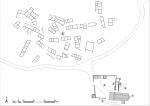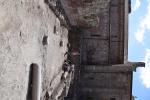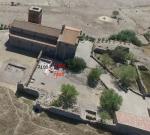Summary (English)
The site, excavated in 2012, is organised into two distinct centres, religious and civic. The ecclesiastical part is characterised by the Romanesque cathedral of Bisarcio and the remains of the bishop’s residence and the rectory, which housed the clergy. The bishop’s residence was a fortified citadel, delimited by a defensive wall and the buildings forming it. The excavation documented an ample diachrony of a multi-stratified site in a dominant position, a central place within the territory, characteristics that decided the choice of the area as the bishop’s seat, around the mid 11th century. Excavation also took place in the area of the rectory and large cemetery (13th-18th century), relating to the neighbouring abandoned village of Bisarcio, which was the object of an archaeological evaluation.
Area 8300
The main aim of the 2018 campaign was to investigate the last portion of the large rectangular building north of the basilica and to check for a possible different use of the space surrounded by the east and south walls (structures of the present curtain wall), with respect to the larger area already investigated during previous campaigns (from 3013 to 2017) that can be attributed to the remains of the bishop’s rectory of Bisarcio. Area 8300 is situated within a vast architectural complex that develops to the north of the basilica and which today appears as a large fortified courtyard. During this season’s campaign, the work aimed to complete the excavation of the entire surface area between the curtain wall structures and to understand the function of the northernmost part of the space, delimited by wall US 8324 and the northern perimeter. The part excavated in 2018 was the northernmost part of the building, between the north and east perimeter walls (US 8371 and 8372) of which several blocks belonging to the first course of the west perimeter wall (US 7709) are visible. The latter were uncovered to a modest height and only partially in length. The wall had undergone progressive robbing. A completely different stratigraphic sequence from that uncovered elsewhere was documented in this part of the room. The sequence was badly disturbed by actions that substantially pre-dated the abandonment of the building, which have compromised the legibility of the evidence and interpretation of the original context. This area primarily presented the robbing of the walls, evidence of the building site for the walls, and recent disturbance caused by restoration work on part of the curtain wall, which cut, starting from the present floor surface of the courtyard, all of the stratigraphy down to the original floors, compromising its correct reading.Area 5100
Area 5100, immediately north of the north side of the basilica of Sant’Antioco di Bisarcio, covers a quadrangular area of 100 m2 divided into four squares, sectors 1, 2, 3, and 4, plus an extension denominated sector 5. In 2018, excavations took place to the east of the perimeter wall of the episcopal complex and close to the north side of the basilica. During recent investigations research concentrated on sector 5 where work continued on the analysis of the cemetery deposits present in this part of the area, of which the latest phase was identified in 2017. The investigation of the 12th century construction site levels, relating to the building of the eastern perimeter wall of the episcopal complex, also continued. These levels extended over a pre-existing building whose chronology and function remain to be clarified, but probably dated to the late antique period. The recent excavation campaigns have made it possible to begin to define the characteristics of a large sample of the necropolis used by the inhabitants of Bisarcio, dating, at present, to between the late medieval and modern periods. To date 53 burials have been identified divided between three burial phases (tab. 2). The overall number of burials also includes the 17 burials, found in 2015, dating to between the late 18th and early 19th centuries, which cannot be attributed to a specific cemetery phase, but appear to be the result of a random event in a period when Bisarcio was already in a state of abandonment.
- Marco Milanese - Università degli Studi di Sassari
Director
Team
- Nadia Canu - Soprintendenza Archeologia, Belle Arti e Paesaggio per le Province di Sassari e Nuoro
- Alessandra Deiana - Università degli Studi di Sassari
- Anna Bini - Università di Sassari
- Giovanni Frau
- Maria Chiara Deriu - Università degli Studi di Sassari






![Download [PDF]](/excavation/skins/fasti/images/results/download_sml.png)


